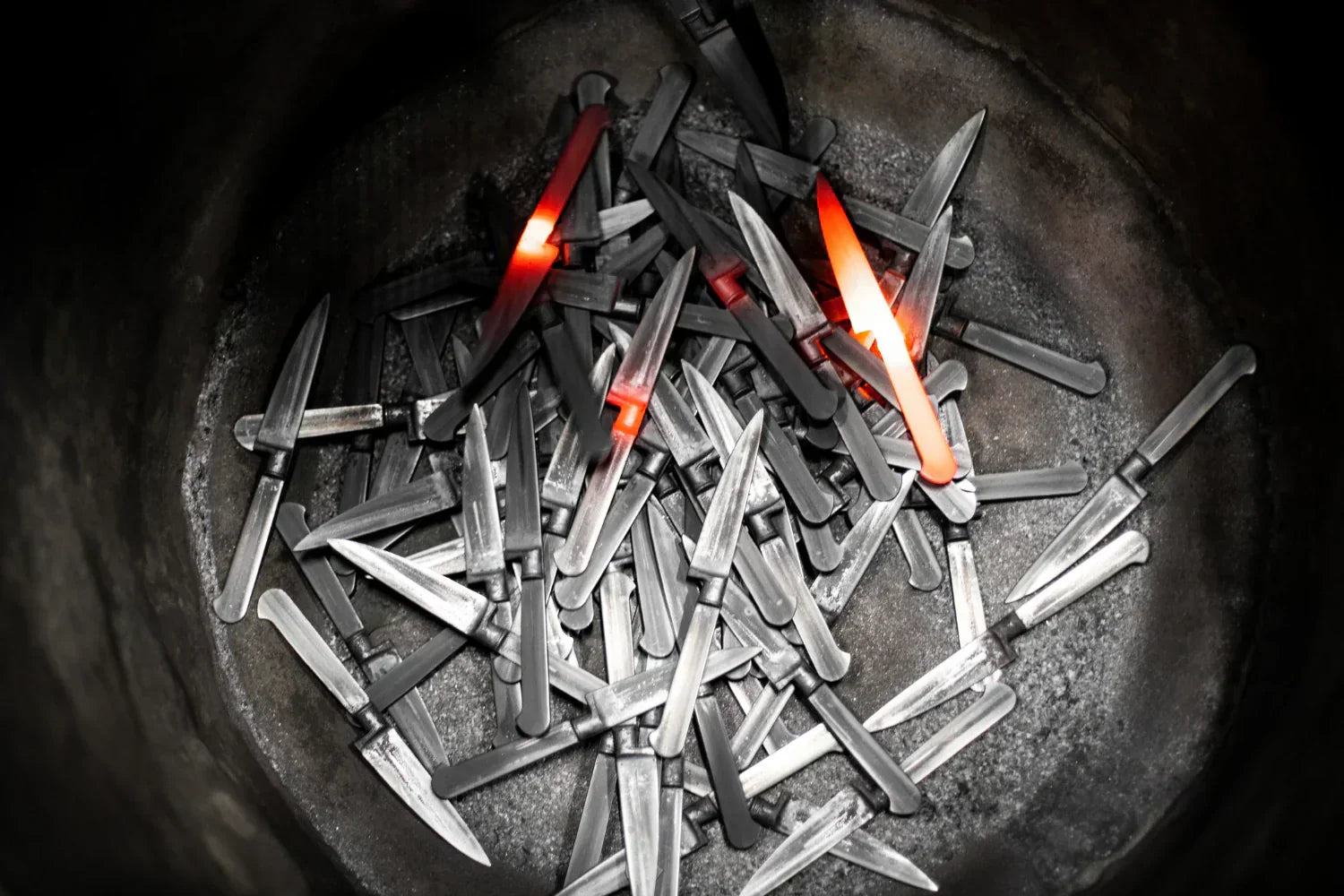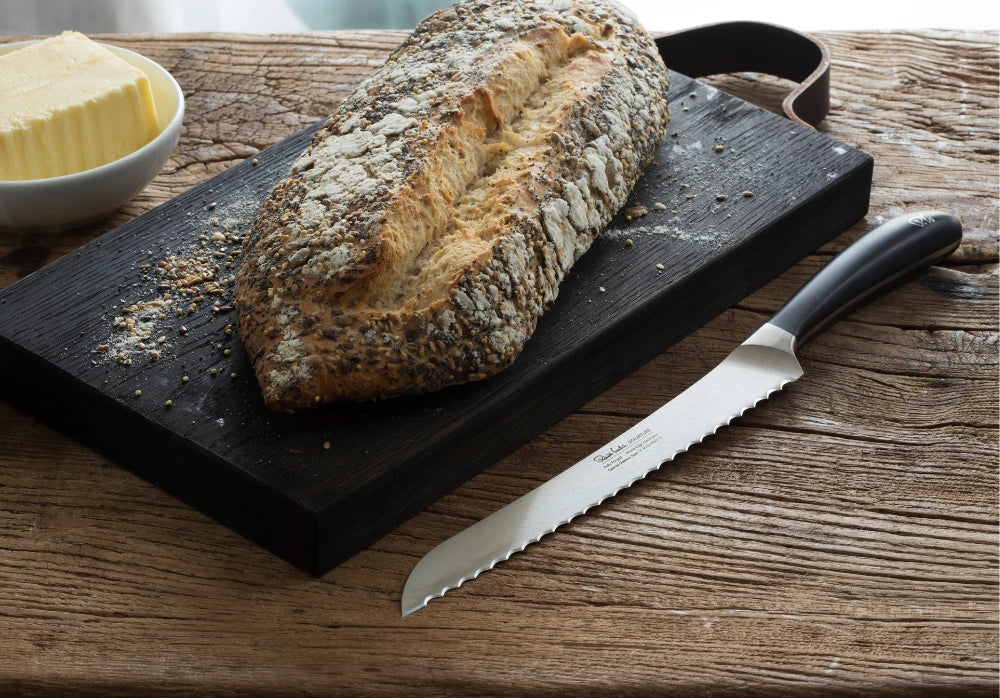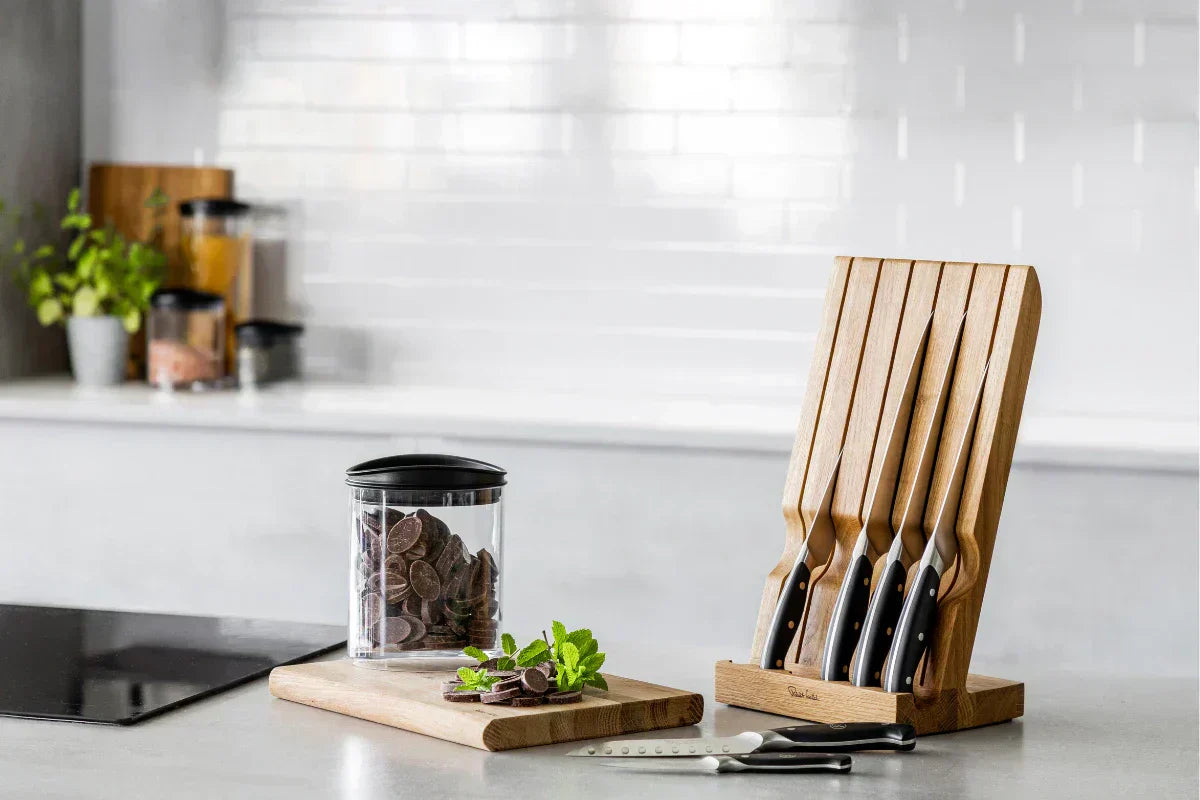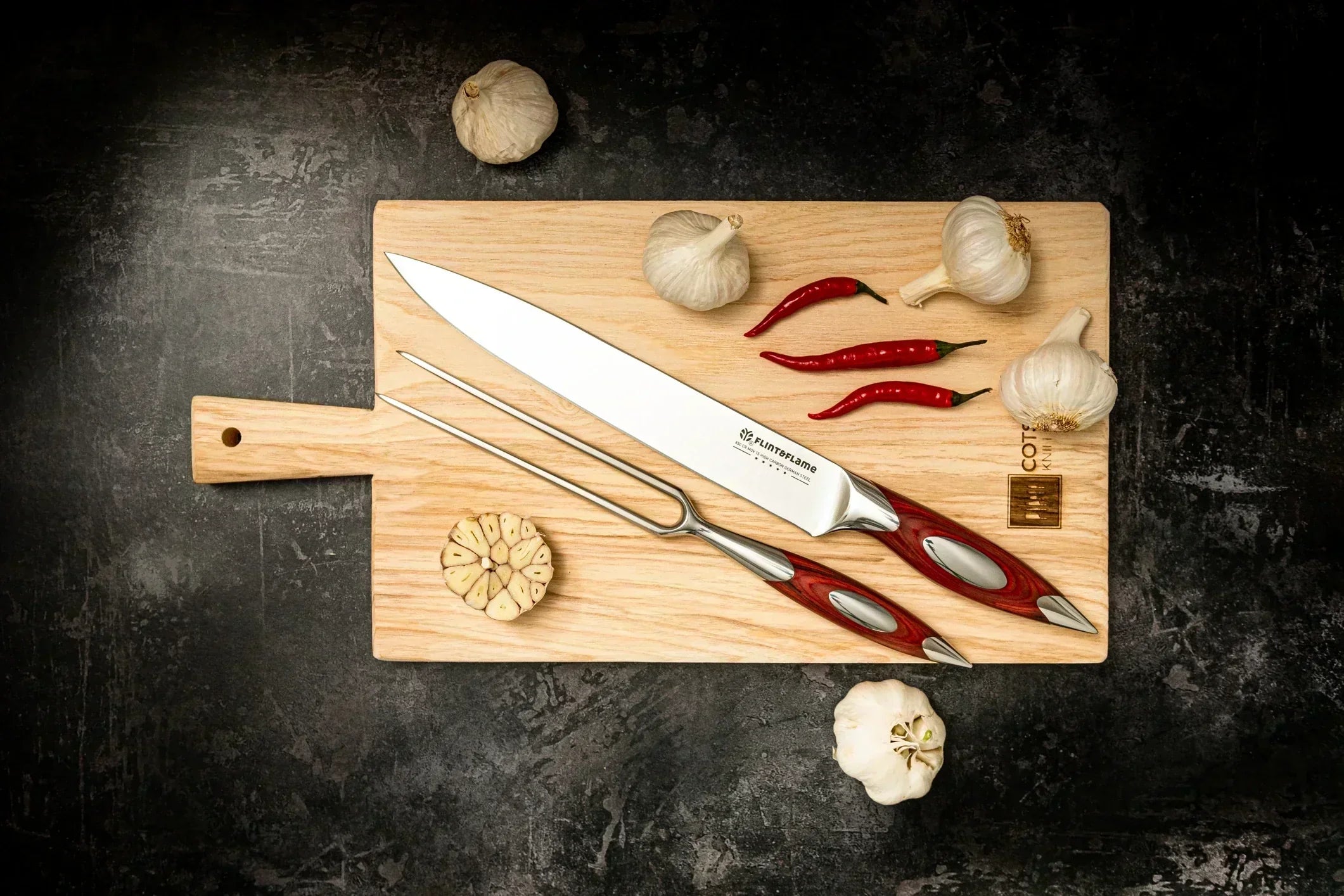The Ultimate Guide to High Carbon Steel Knives: History, Benefits, and Care

For centuries, carbon steel has been the material of choice for artisans and chefs seeking sharp, durable, and high-performance blades. While stainless steel knives gained popularity in the 20th century for their ease of maintenance, carbon steel is making a strong comeback among serious cooks and professionals who prioritise precision and longevity in their kitchen tools.
The Science Behind Carbon Steel's Performance
Carbon steel is a blend of iron and carbon, with carbon content typically ranging from 0.5% to 1.5%. The presence of carbon is what allows the steel to be hardened, which results in a sharper and longer-lasting edge. Unlike stainless steel, which contains chromium for rust resistance, carbon steel has a simpler composition that enhances its ability to form a fine, keen edge.

Carbide Formation and Grain Structure
In carbon steel, the carbon forms carbides during heat treatment. These carbides contribute to a refined grain structure, enabling a very thin, keen edge. This is why carbon steel blades can achieve and maintain such exceptional sharpness.
Hardness (HRC)
The Rockwell Hardness (HRC) scale measures how hard the steel is. Carbon steel can be heat-treated to a higher HRC than most stainless steels without becoming too brittle. This higher hardness means the edge remains sharp longer, though it also requires proper forging and tempering to maintain toughness.
Comparing High Carbon Steel and Stainless Steel
Although both materials share iron as a base element, their differences significantly impact a knife’s performance and maintenance needs.
Edge Retention
Carbon Steel: Tends to keep its edge longer thanks to its higher hardness and fine grain structure, which allow it to be honed to an extremely sharp finish.
Stainless Steel: While premium blends can retain sharpness reasonably well, most stainless steels are softer overall, meaning they lose their edge more quickly than the finest carbon steels.
Ease of Sharpening
Carbon Steel: Often easier to sharpen because its simpler grain structure lets sharpening stones “bite” more effectively for quick, precise honing.
Stainless Steel: Can be trickier to sharpen due to chromium and other alloying elements. Although some specialised stainless formulations do sharpen nicely, they typically require more effort or specific sharpening techniques.
Reactivity
Carbon Steel: More reactive with acidic or damp ingredients, which helps develop a patina that can protect the blade. However, leaving the knife wet for too long increases the risk of rust.
Stainless Steel: Contains at least 13% chromium, making it much more corrosion-resistant and less prone to discolouration.
Durability
Carbon Steel: Extremely strong when forged and tempered correctly, but it can be more brittle under heavy misuse.
Stainless Steel: Less likely to chip in rough conditions but can roll or dent more easily because it’s generally softer.
Myths and Misconceptions About High Carbon Steel Knives
Carbon steel knives are often misunderstood. Here are some common myths and the truths behind them:
“Carbon steel knives rust too easily.” While carbon steel can rust if neglected, proper care—such as drying the blade immediately after use and applying a light coat of oil prevents this issue.
“They are harder to sharpen.” In reality, carbon steel knives are easier to sharpen than most stainless steel knives due to their fine grain structure.
“They are fragile.” While carbon steel can be brittle if mishandled, high-quality forging and proper heat treatment make these knives both strong and durable.

The Craftsmanship Behind High Carbon Steel Knives
The true quality of a carbon steel knife isn’t just about the steel itself, it’s about how the knife is made. Traditional forging methods involve heating, hammering, and carefully shaping the blade to optimise strength and balance.
Heat treatment is one of the most crucial steps. It determines the hardness, flexibility, and resilience of the blade. A well-executed heat treatment enhances edge retention while preventing excessive brittleness.
Hand-forging also allows for differential hardening, where the spine of the knife remains softer for durability, while the edge is hardened for sharpness. This technique results in a more balanced knife that is both long-lasting and high-performing.

How High Carbon Steel Knives Can Enhance Cooking
This razor-sharpness of a high carbon steel knife is genuinely a joy to use, delivering precise, effortless cuts that preserve the integrity and flavour of your ingredients. For instance, slicing fresh herbs with minimal force reduces bruising and the release of essential oils, maintaining their vibrant taste. Likewise, the gentle cut of a carbon steel blade helps keep meats tender and juicy. When every slice is smooth and controlled, cooking becomes more rewarding, and the results more delicious.
Developing & Maintaining a Patina On Your Carbon Steel Blade
One unique feature of carbon steel knives is their ability to develop a patina, a natural discolouration that forms over time. Patina acts as a protective barrier against rust and gives the blade a distinct, character-rich appearance.
- Encouraging a Patina Naturally - Regular use with acidic foods like onions, citrus, and tomatoes will gradually darken the blade.
- Forcing a Patina - Some users speed up the process by applying mustard, vinegar, or coffee to the blade.
- Removing Red Rust - Unlike patina, red rust should be removed immediately using a mild abrasive like baking soda or a metal polish.
Pros of a Forced Patina:
- Immediate Protection: Forcing a patina can quickly create a layer that helps resist rust.
- Custom Aesthetics: You can experiment with patterns and colours, especially when using mustard or other thick, spreadable substances.
- Control Over the Outcome: By applying the solution in specific areas, you can create a more uniform or artistic finish.
Cons of a Forced Patina:
- Less Organic Appearance: Some people prefer the natural, gradual evolution of their knife’s patina for sentimental or aesthetic reasons.
- Potential Unevenness: If not done carefully, forced patina methods can produce blotchy results.
- Possible Over-Acidity: Leaving highly acidic substances on the blade too long might weaken or pit the surface if not rinsed and neutralised properly.
In the end, whether to force a patina is a personal choice. If you like a uniform look or want immediate protection, it can be a great option. However, letting the patina develop naturally often carries its own charm and story.

Care and Maintenance For High Carbon Steel Blades
Carbon steel knives do require consistent care, but it’s a simple routine once you get used to it:
Wash Immediately After Use- Gently rinse the blade in warm water to remove food particles. Avoid abrasive sponges that can scratch the metal.
Dry Thoroughly- Wipe the knife with a soft towel until it’s completely dry, paying attention to the edge and handle junction.
Oil the Blade- If you’re storing the knife for an extended period, apply a thin layer of food-grade mineral oil or camellia oil to prevent moisture contact.
Store Properly- Keep it in a knife block, on a magnetic strip, or in a blade guard to protect both the edge and your fingers.
Sharpen Regularly- Frequent touch-ups can prevent the need for a major re-sharpening session later.
Removing Rust and Reconditioning
Surface Rust: Can often be wiped off with a soft cloth and a mild abrasive like baking soda.
Deeper Rust: Use fine-grit sandpaper or a rust eraser to remove stubborn rust. Re-sharpen and oil the blade afterward.
Complete Reconditioning: If the blade has been neglected for a long time, consider taking it to a professional for restoration.
Common Care Mistakes to Avoid Damage to Your High Carbon Blades
To ensure your carbon steel knife lasts a lifetime, avoid these common mistakes:
- Leaving it wet - Always dry your knife immediately after washing.
- Using a dishwasher - The harsh detergents and moisture will accelerate rusting and damage the handle.
- Storing it improperly - Keep your knife in a dry place, preferably on a magnetic knife strip or in a blade guard.
- Using the wrong cutting surface - Hard surfaces like glass or stone can dull the edge quickly; opt for softer surfaces such as wooden chopping boards.
Don’t be put off high carbon knives
- Extra Care Isn’t Difficult - Think of carbon steel care as a quick rinse and wipe, simple habits that become second nature.
- Beginners Are Welcome - You don’t need to be a professional chef to handle carbon steel. Many home cooks find the extra care steps effortless once they see the performance benefits.
- Patina Is a Plus - Patina isn’t a flaw, it’s a functional layer that guards against corrosion and tells the knife’s unique story.
Why High Carbon Steel Knives Might be Suited for You
Choosing the right knife ultimately comes down to personal preference. Stainless steel knives excel in convenience and low maintenance, making them an excellent option for busy kitchens and those who prefer minimal upkeep. However, if you value a blade that offers exceptional sharpness, develops a uniquely personal patina, and rewards you with a hands-on, traditional ownership experience, a carbon steel knife may be the perfect match.
Performance and Character
Carbon steel knives are renowned for their ability to hold a remarkably fine edge and adapt over time, developing a patina that reflects the meals you’ve prepared. This evolution connects you more deeply with your knife, turning it into an extension of your cooking style rather than just another tool.
Rewarding Routine
While carbon steel requires a bit more care, cleaning, drying, and occasional oiling, many cooks find these extra steps to be a satisfying ritual. If you enjoy the process of looking after your equipment and appreciate the benefits of a blade that stays sharper longer, carbon steel is a natural fit.
Your Choice, Your Kitchen
We offer both premium carbon steel and high-end stainless-steel knives because each chef’s needs and preferences are unique. If you’re looking for a knife that provides unparalleled performance, a personalised patina, and a rich sense of heritage, a carbon steel knife from could become your most prized kitchen companion.




